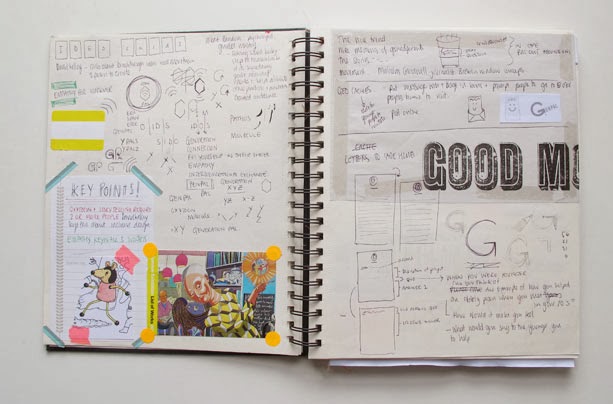Whilst researching information to share with the group via our facebook group page I followed the research in my sketchbook trying to link the 3 subjects and find out what they each had in common or trying to find new threads to follow.
I begin to realise a connection between each of the subjects we had chosen where by finding out what makes people happy (the release of oxytocin) we could encourage people to share their stories (storytelling) and then from this find out how to make other people happier (inclusive design) this created a full circle which could be a never ending loop. (see diagram sketch above) We discussed what makes people happy based on personal experience and our research so far. Connections to people, giving, touching, warm temperatures, having meals, being social, sharing stories, balloons. We started to put questions together that we could ask other people outside of our group such as
- What makes you happy?
- How could your day/life be improved?
- What is the most memorable moment in your life?
From this we decided that the main basis of our project would be to go out and find out what makes people happy. From this we would pass the story onto others in the hope it would make them happy or realise that they could perhaps help someone else to be happy in some way by helping them. Rather than like most Inclusive Design products we wanted to create a movement to reach out to the wider audience who perhaps have no knowledge of the issues we were looking at. Hoping through doing this it will encourage more people to be active in the pursuit of happiness.
Ageing population - This was also brought about a lot within the group research and discussion. We began to look at the generations X, Y & Z (see here for more details of the three) Our group are in the the Y generation which is the largest cohort since the baby boomers. This started us questioning what it will be like when we get old and what did we think would make us happy. Comparing this to what makes the older generation happy these days - letter writing, spending time with other people, particularly those in the family of a younger generation. From this we wanted to encourage more young people to take time out and help or spend time with the elderly and to learn from their experiences to help them understand what might make them happier when they are older.
Initial project ideas - From the above we decided to gather stories from our generation about how they have helped an elderly person. To then pass this story on in some way to more of our generation to encourage them to think about these things and perhaps encourage them to do something nice for an elderly person. From our previous research we realised that gift giving or warm temperatures (i.e. warm drinks) released oxytocin. And so our initial idea became about writing these stories or findings onto the hand protectors of the Art School's coffee cups. Alongside the story would be a question put to the person drinking the coffee which they would fill out and drop into a "post box" in the cafe area.
This idea soon developed as we thought more about our previous research, which brought us back to letter writing. With the same concept in mind this brought about our second initial idea which we followed through with.
GENPAL - The idea of GENPAL was to take out a sort of letter/questionnaire that would begin it's journey in an elderly care home. The identity and format of the project was realised and the next day Patti and Steve were ready to spend the day in a care home gathering the information. Once this information was gathered, the next step would be to bring these letters back sealed in an envelope and distribute them among the Art School cafe to the younger generation. They would read the response from the elderly and then respond in return themselves. Once again sealed, these letters would be taken back to the elderly person who wrote that particular letter to read the response made by the younger person.
Below - Logo identity for the GENPAL project. Logo on the right was developed from group discussions.
Feedback - Logo on right looks too much like a council re-cycling logo, and so does the green colour used.
Our project soon hit a wall when we weren't allowed into any of the homes (despite knowing someone who could get us in!) and so we had to come together as a collective again to re-think where else our project could take us.















No comments:
Post a Comment